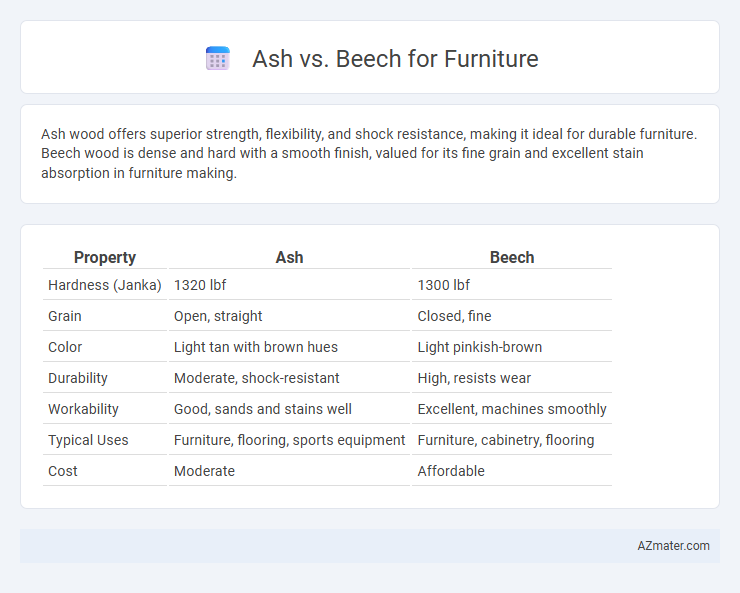Ash wood offers superior strength, flexibility, and shock resistance, making it ideal for durable furniture. Beech wood is dense and hard with a smooth finish, valued for its fine grain and excellent stain absorption in furniture making.
Table of Comparison
| Property | Ash | Beech |
|---|---|---|
| Hardness (Janka) | 1320 lbf | 1300 lbf |
| Grain | Open, straight | Closed, fine |
| Color | Light tan with brown hues | Light pinkish-brown |
| Durability | Moderate, shock-resistant | High, resists wear |
| Workability | Good, sands and stains well | Excellent, machines smoothly |
| Typical Uses | Furniture, flooring, sports equipment | Furniture, cabinetry, flooring |
| Cost | Moderate | Affordable |
Overview: Ash vs Beech Wood
Ash wood features a light color with a straight grain pattern, known for its strength and elasticity, making it ideal for durable furniture. Beech wood has a fine, tight grain with a pale cream color and is valued for its hardness and resistance to wear, offering a smooth finish for furniture surfaces. Both woods exhibit excellent workability, but ash provides greater shock resistance while beech excels in wear resistance and stability.
Appearance and Grain Patterns
Ash wood features a light, creamy color with a straight, open grain that often displays striking, cathedral-like patterns, making it ideal for modern, airy furniture designs. Beech wood, typically pale pinkish to reddish-brown, offers a fine, tight grain with a smooth, even texture, providing a more uniform appearance suited for classic and contemporary styles. Both woods deliver distinctive aesthetics, with ash highlighting bold, dynamic grains and beech emphasizing subtle, consistent visuals.
Strength and Durability Comparison
Ash wood exhibits higher tensile strength and exceptional shock resistance, making it ideal for furniture that requires durability and resilience. Beech wood, while hard and heavy, has a slightly lower strength-to-weight ratio but offers excellent wear resistance and stability under varying humidity conditions. Both woods are highly durable, but ash is preferred for heavy-use furniture due to its superior flexibility and impact absorption.
Workability for Furniture Making
Ash wood offers excellent workability for furniture making due to its straight grain and moderate hardness, allowing for easy cutting, shaping, and sanding while maintaining durability. Beech wood also features smooth workability with fine, tight grain, making it ideal for both hand and machine processing, though it tends to be harder and may require more effort in machining compared to ash. Both woods respond well to finishing and gluing, but ash's flexibility and shock resistance make it particularly favored for furniture requiring strength and resilience.
Cost and Availability Analysis
Ash furniture offers a cost-effective option due to its widespread availability and rapid growth rate, making it more affordable than beech wood. Beech wood, known for its fine grain and hardness, often commands higher prices because it is less abundant and harvested primarily from European forests. Both woods are readily available on the market, but ash's lower cost and abundant supply make it a popular choice for budget-conscious furniture manufacturers.
Resistance to Wear and Tear
Ash wood is highly favored for furniture due to its superior resistance to wear and tear, offering excellent durability in high-traffic environments. Beech wood, while also durable, tends to be slightly less resistant to dents and scratches compared to ash, making it more susceptible to visible wear over time. Furniture crafted from ash provides enhanced longevity and maintains its structural integrity better under frequent use.
Environmental Impact and Sustainability
Ash wood, known for its rapid growth and renewability, offers a more sustainable option for furniture due to its high carbon sequestration and lower environmental footprint compared to Beech. Beech trees grow slower and require more intensive forestry management, increasing the ecological impact associated with their harvesting. Choosing Ash furniture supports reduced deforestation rates and promotes sustainable woodland ecosystems through responsible forest management practices.
Finish and Staining Qualities
Ash wood offers exceptional finish qualities due to its open grain, allowing smooth application and uniform absorption of stains, which enhances its natural light color and grain patterns. Beech wood features a fine, tight grain that provides a smooth surface ideal for finishes, but it tends to absorb stains unevenly, often resulting in a blotchy appearance unless pre-treated with a wood conditioner. Both woods respond well to clear finishes, but ash's staining qualities make it preferable for furniture pieces seeking pronounced grain visibility and vibrant color enhancements.
Common Furniture Applications
Ash wood is highly favored for furniture due to its strength, flexibility, and attractive grain, commonly used in chairs, tables, and cabinetry where durability and aesthetic appeal are essential. Beech wood offers a tight grain and smooth finish, making it ideal for mass-produced furniture such as benches, stools, and kitchen cabinets that require a consistent, uniform look. Both woods are valued in furniture-making, with ash preferred for its resilience in high-stress applications and beech chosen for cost-effective, finely finished pieces.
Pros and Cons: Ash vs Beech
Ash wood offers a light color with a pronounced grain pattern, providing strong durability and elasticity, making it ideal for sturdy furniture like chairs and tables. Beech wood is dense and hard with a fine, uniform texture, giving furniture a smooth finish and excellent resistance to wear and dents, but it can be prone to moisture absorption causing swelling. Ash is more flexible and shock-resistant, perfect for furniture requiring resilience, whereas beech is better suited for items needing a polished, refined appearance but demands careful moisture control.

Infographic: Ash vs Beech for Furniture
 azmater.com
azmater.com